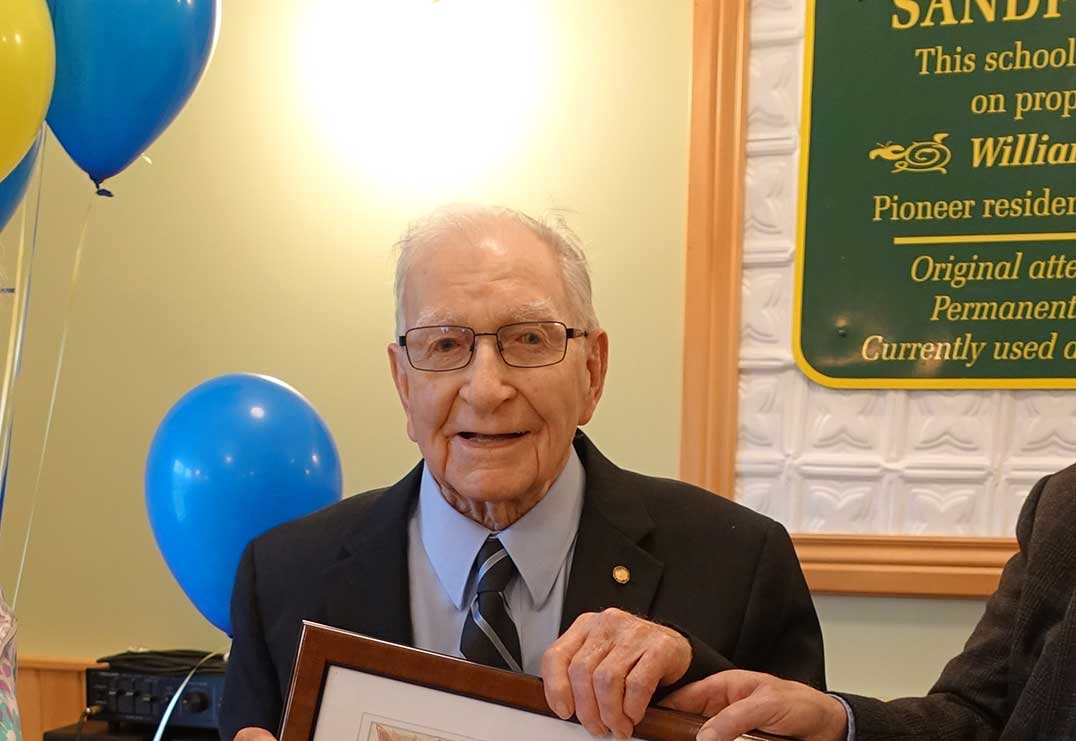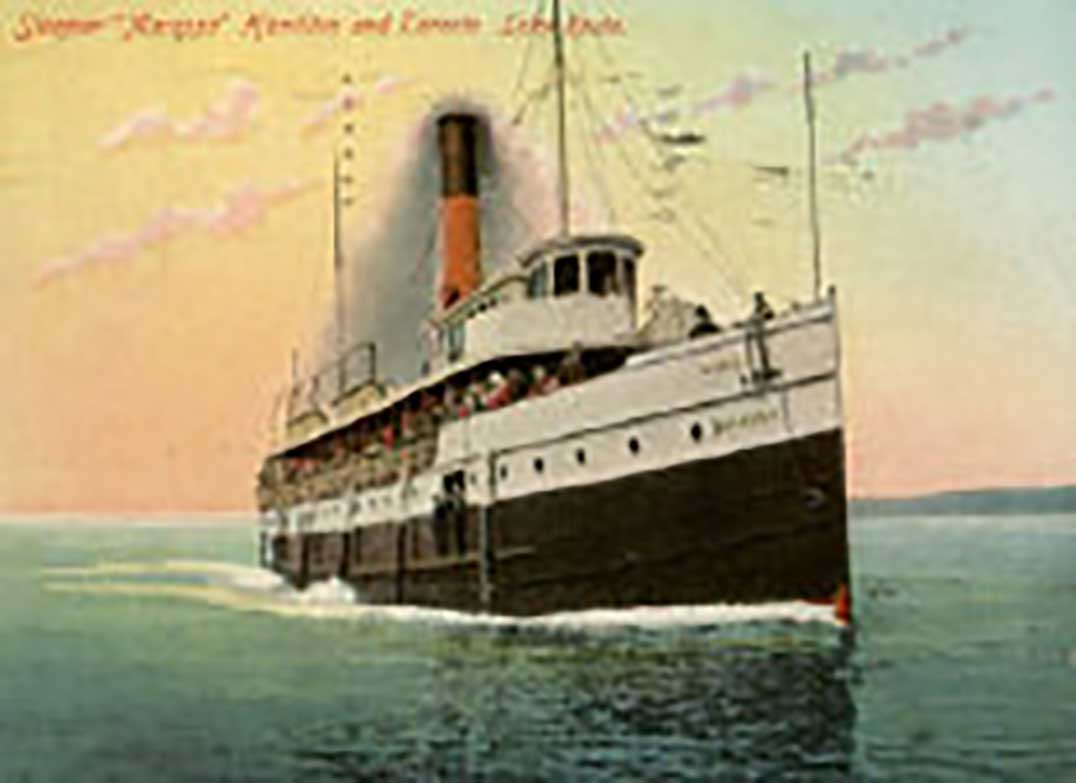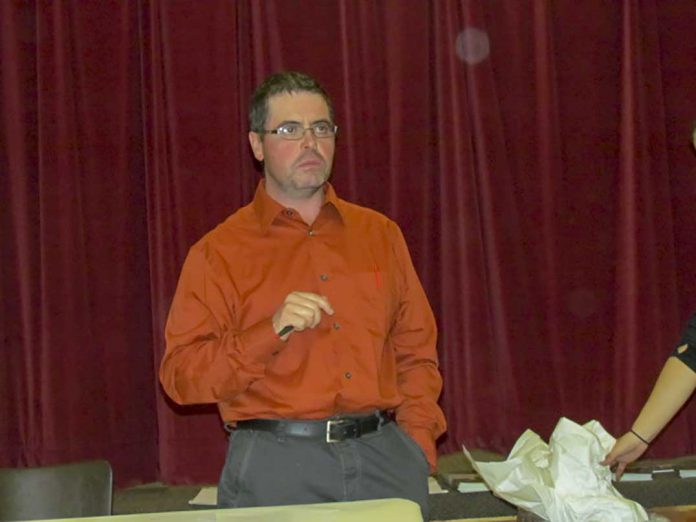Sandfield elder Andy Watson recalls driving cattle to the ship in Manitowaning
GEORGIAN BAY—Just weeks before the news that the S.S. Manasoo had been discovered in 200 feet of water near Owen Sound in Georgian Bay, Tom Carrick had been chatting with his 101-year-old uncle Andy Watson of Sandfield. Mr. Watson had told him about the time he drove cattle to a ship called the Manasoo.
Mr. Carrick thought it fortuitous that, just weeks later, the topic of the Manasoo arose once again with the front-page Expositor story that detailed diving crews finding the Owen Sound Transportation Company-run vessel in the depths of Georgian Bay. Mr. Watson was just 11 years old at the time of the sinking, September 15, 1928.
“I remember when it sank,” Mr. Watson told The Expositor when contacted last week.
As a youngster, Mr. Watson was involved in two cattle drives during a stint when his father got into the cattle business—one drive to Manitowaning, where he brought cattle to be loaded aboard the Manasoo on what may have been the ship’s last trip, and the other to South Baymouth.
He explained that cattle buyers would come to Manitoulin and drive around to the farms, buying cattle until they had enough to make a load on one of the vessels.
“They said the cattle went to one side and that’s why it sank,” Mr. Watson said. “They usually had them (cattle) penned off so they couldn’t all go to one side.”
Mr. Watson went on to note that the vessels that were used to bring tourists to Manitoulin in the summer months were converted to carry cattle come fall.

According to an article on the Manasoo from the website steamboatstories.ca, from June until September 10, 1928 the Manasoo “travelled on a regular timetable transporting pleasure seekers, businessmen, farmers and salesman to and from Manitoulin Island. There was a licenced capacity for 70 passengers. At the end of the passenger season in September, the ship was taken out of regular service and repurposed for moving livestock. Now large pens were set up on the main deck. Linens were stowed away except for a few staterooms where the few remaining waiters took advantage of the unoccupied spaces to escape from their cramped quarters below.”
The article goes on to note that 1927 and 1928 were good years for cattle farmers with high prices and excellent demand. Drovers flocked to Manitoulin to buy livestock for southern Ontario markets. The cattle were then boarded on such vessels as the S.S. Hibou, S.S. Manasoo and the S.S. Manitoulin.
Donald Wallace, a cattleman, drove his 1927 Chevrolet coupe from Oil Springs, near Sarnia, to catch the Manasoo at Owen Sound. He brought with him his friend Thomas Lambert. Just like Mr. Watson explained, Mr. Wallace made the round to farms across Manitoulin, purchasing $5,600 worth of cattle. Farmer Thomas Turner added another 18 to the herd Mr. Wallace purchased and these cattle were purportedly loaded at West Bay, now M’Chigeeng.
Keith Hopkin, a steamship historian, formerly of Manitoulin, questions the West Bay load and believes that Honora Bay may have been the actual port where the cattle were loaded. At the time, Honora Bay was a busy port with the docking capacity for larger vessels such as the Manasoo. The ship then headed for Manitowaning as its final Island port of call.

“This was Mr. Wallace’s first experience to transport cattle by boat,” the steamshipstories.ca article states. “He noticed that, unlike transport by railway box cars where bedding was hay, bedding on the Manasoo was sawdust, and pen slats were not nailed to posts, they were tied and knotted with rope to metal stanchions and pens had two plank slats instead of four or five. He said nothing as the crew knew what they were doing. In fact, this penning technique was used the week before on the S.S. Manasoo and it was quite satisfactory.”
On September 14, the Manasoo left Manitowaning at noon, expecting to arrive in Owen Sound in the early morning of September 15.
Mr. Wallace and Mr. Lambert enjoyed a steak dinner at 6 pm that evening aboard the Manasoo, Mr. Wallace, who survived the sinking, recalled later, the steamboatstories.ca article continues. “The ship was ‘going nicely’ with a gentle roll when they feel asleep after 10 pm. The two were awakened by a slight list, pitching seas and an electrical storm well after midnight but they went back to sleep.”
When conditions worsened, the two were awakened by a sharp list that slid the mattress to the foot of the bed. The pair dressed and made it to the alleyway. “At the same time the Second Mate, Frank Hutcheson, ran past exclaiming ‘My God, my God’ while swinging a lifebelt above his head. He said nothing more and disappeared down the now-slanting alley.”
Mr. Wallace, without a lifejacket, was scared the boiler would blow and, not wanting to risk it, jumped into the churning water. He never saw his friend Mr. Lambert again.
There were six men on one of the boat’s life rafts: oiler Roy Fox, Captain John McKay, Chief Engineer Thomas McUtchen, Mr. Wallace, Mate Osborne (Oz) Long and Arthur Middleboro.
“The men sat on their slatted raft and noticed that the Griffith Island Lighthouse was about a half-mile away,” the steamboatstories.ca article continues. “They had no paddle so they used their hands in an attempt to reach the island.” A west wind began to blow, charting them off-course for the safety of Griffith Island.
The crew drifted further and further east as the sun rose that morning. That Saturday was described as “blisteringly hot” and the survivors became badly burned. Day turned to night and into morning again when they realized that they were nearing Christian Island. The west wind, however, shifted to south east and blew the raft off course once again, pushing it once again to Griffith Island. At this point the pontoons began to take on water. By Sundown Sunday, they were all suffering from exposure.
At approximately noon Monday, Chief Engineer McUtchen (who had recently immigrated from Scotland) became unconscious and by 2 pm he was dead. They removed his clothes and distributed it among the remaining crew. “With little ceremony, his body was rolled into the water.” The body was never recovered.
At 3:15 pm that afternoon, the Canadian Pacific Railway S.S. Manitoba’s First Officer Jack McCannell, while heading from Port McNicoll to Sault Ste. Marie, caught sight of the raft, reversed engines, blew an alarm signal and called Captain Francis Davis. The five survivors were rescued soon after and taken to hospital in Owen Sound.
An investigation into the sinking was launched by the Department of the Marine in Owen Sound the first week of October with witnesses ranging from survivors to naval architects to company officials called to testify, according to steamboatstories.ca.
“Rumours abounded in the city,” the article noted. “This was fueled by the testimony of Donald Wallace who claimed that Captain McKay, while on the raft, told his crew that they had to agree on one story.” Captain McKay lost his captain’s licence as a result, but after much protest, had it reinstated two years later, in 1930.
Mr. Watson was indeed correct. The cattle were loose in their pens below deck and, with no ballast to create a centre of buoyancy, added to a list of potential reasons why the Manasoo sank.
As was reported previously, three Islanders lost their lives in the sinking: Joseph Mansour, a waiter, age 21, of Little Current and cousins and deck hands Ely Shawana, 17, of Sheguiandah and Ambrose Shawana, 16, of Manitowaning.




